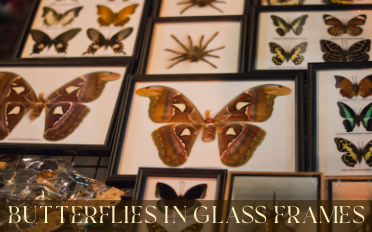Glass-Framed Butterflies | Information All Entries

Once the butterfly or moths life cycle is complete, they're collected by the butterfly farmers and placed in frames by local artisans. These frames provide fair income for the artisans and their families, and each frame is labeled by a licensed biologist in Peru with their scientific names. All the butterflies used in these frames are in the common butterfly family and are not endangered species. The frames look best when hung near natural light, but it is recommended that you keep them out of direct sunlight and moist environments.
Butterflies represent transformation and happiness, bringing color to life.
Monarch Butterflies are easily one of the most recognizable butterflies on Earth, highly studied and famous for their color and seasonal migration. As gorgeous as these creatures are, they are actually poisonous! Bright colors in nature are usually a sign of danger, and it is no different with this butterfly. They feed on milkweed when they are caterpillars, which contain poisonous chemicals that protect themselves from predators.
Owl Butterflies defend themselves from any predators, these owl butterflies have a special defense! The eyes on their wings are scientifically proven to scare off predators, and are found in Rainforests in Mexico, Central America, and South America. There are roughly twenty species of Owl butterflies, subdivided into 6 groups. Studies on the function and mimicry defense of these butterflies have been discussed since the 19th century, and are still in discussion to this day!
The Morpho Helena butterfly is a beautiful iridescent species that is found in South American rainforests, blue with a white stripe. The Cacica butterflies are similar, but most lack the staple white stripe of Helena, and have a more soft and feathered appearance. The metallic blue color you see is actually a trick of the light! Under a microscope, you can see the diamond shaped nanoscales that interfere with light, causing us to perceive the butterflies as Blue. This blue is even said to temporarily blind some animals, and can be effective in large groups that are visible from a plane!
The swallowtail butterfly can be found in North and Central America, and has a black color with gorgeous iridescent blue wings. They are most commonly found in forests and feed on plants in the carrot family, generally having a decently large wingspan. This buttery, unlike the Helena Morpho butterfly, does NOT use light scattering to create the metallic blue. The color you see is just the natural pigmentary color of the butterfly, and not a trick of the light!
These gorgeous moths are black with iridescent orange and green markings, earning the nickname of Sunset Moth! These moths share a very similar appearance to brightly colored butterflies and are usually toxic, the bright colors are signs of warning for both the Caterpillar and the adult grown moth as the caterpillars feed on a poisonous plant during the growth process.